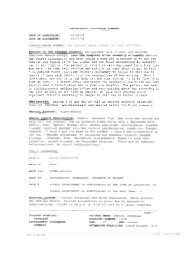C - Organized Mobbing
C - Organized Mobbing
C - Organized Mobbing
You also want an ePaper? Increase the reach of your titles
YUMPU automatically turns print PDFs into web optimized ePapers that Google loves.
Attempting to Know and Control the Opposition 507 1<br />
stances the radicalization of the movements could not be in the interest of<br />
the Stasi since trials were unlikely to come forth Accordingly, except<br />
for those informants who seem to have pursued their personal agenda,<br />
in playing their double role as secret informant acting within the Stasi's<br />
rules of engagement they could not advance to first tier group leadership<br />
positions.39<br />
The problem with selective recognition as a tool of influence was amplified<br />
if the recognizing agents were readily identifiable as agents of the state.<br />
This was typically the case with the Stasi's use of "social forces," who were<br />
often enough recognizable as party members by linguistic register, habitus,<br />
and dress. Thus identified they typically became anti-authorities for the activists.<br />
As far as recognitions are concerned the epistemic effect of the action<br />
thus achieved exactly the opposite of what it was meant to accomplish.<br />
What the Stasi could do in the most extreme cases was to literally inundate<br />
an open group with the presence of social forces. The effect was produced in<br />
such cases not through selective recognition, but by corroborating the fear<br />
that party-critical work was futile anj7va): The Pankow peace circle was, for<br />
all practical purposes, dissolved in this manner (Lengsfeld 1992).<br />
The case of the anonymous letter to the women's group still holds other<br />
lessons. In principle the method of planting destructive understandings is<br />
limited by the understandings already actualized in the group so that they<br />
can enjoy plausibility through their underlying resonances. Since such<br />
understandings are often emotive rather than discursive, they take empathy<br />
to discover with sufficient precision. With its anonymous letter to the<br />
women's group the Stasi had calculated correctly. Its claims obviously hit<br />
a raw nerve with the feelings of a significant number of group members.<br />
And yet, the discursive culture prevailing in the group enabled the women<br />
to work constructively with disagreements. In particular, they resisted the<br />
de-authorization of other group members in the face of contradicting recognitions.<br />
This success at defusing subversion has an institutional and more<br />
contingent basis. Institutionally, the women's resolution of the conflict was<br />
enabled by a number of closer, even intimate friendships that offered spaces<br />
38. One of the last acts of Monika Hager as a secret informant was to write a short analysis of<br />
how to improve the work nlth secret informants in the Stasi. ?here too she argues that infor-<br />
mants should be allowed to become more active to acquire authority within any group (1989<br />
Passim, especially 25).<br />
39. This can be argued, for example, for Wolfgang Wolf (alias "Max") who was a vocal member<br />
ofthe Friedrichsfelde peace circle (BVB, AKG, April 12,1989). It can also be argued for Ibrahlm<br />
Bbhme (alias "Maximllian") who became an important member of the IFM (Lahann 1992,<br />
'09-27) after its near breakdown in 1988 (see below). In the Prenzlauer Berg's poetry scene, Sas-<br />
ha Anderson (IM "Fritz Miiller" or "David Menzer") and Rainer Schedlinski (IM "~erhard"),<br />
Played a similarly active, and in the Stasi's view, ambiguous role.<br />
r





